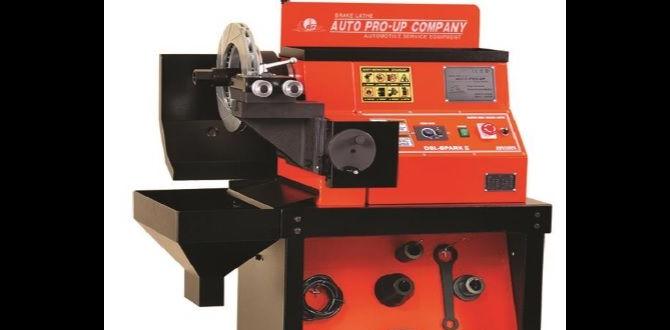Quick Summary: A 1/8-inch carbide end mill is indispensable for working with brass, offering precision, durability, and chatter-free cuts. Its small size and sharp edges make it perfect for intricate details and smooth finishes on brass projects in your metal lathe or milling machine, ensuring excellent results for hobbyists and makers.
Hey there, fellow makers! Daniel Bates here from Lathe Hub. Ever tried to get a super clean cut on brass with your milling machine and ended up with a fuzzy mess or a tool that just wasn’t cutting it? It’s a common headache, especially when you’re aiming for those fine details on your projects. The good news is, there’s a secret weapon for tackling brass with ease: the 1/8-inch carbide end mill. In this guide, we’ll dive into why this particular tool is a game-changer for anyone working with brass, from hobbyists to serious machinists. Get ready to unlock smoother cuts and more impressive finishes on your next brass project!
Why a 1/8-Inch Carbide End Mill is Your Brass Best Friend
When you’re working with softer metals like brass, you need tools that are sharp, precise, and strong enough to handle the material without causing it to deform or chatter. That’s where the 1/8-inch carbide end mill shines. Its small diameter is perfect for detailed work, while the carbide material ensures it stays sharp and strong, even when machining tougher materials.
Let’s break down why this specific tool is so highly recommended for brass:
- Precision for Details: The 1/8-inch size is fantastic for creating intricate designs, small holes, internal corners, and fine features that larger end mills just can’t achieve. Think jewelry, model making, or intricate engraved plates.
- Carbide Durability: Carbide is a super-hard material, much harder than High-Speed Steel (HSS). This means it can withstand higher temperatures and wear much better. For brass, this translates to longer tool life and consistent cutting performance.
- Smooth Finishes: A sharp, high-quality carbide end mill, especially when used correctly with the right speeds and feeds, will leave a remarkably smooth surface finish on brass. This often means less secondary finishing work for you.
- Reduced Heat Buildup: While brass is relatively soft, machining can still generate heat. Carbide’s heat resistance helps prevent the tool from softening and dulling as quickly as HSS might under similar conditions.
- Chatter Reduction: A well-balanced and sharp carbide end mill, combined with proper machining practices, can significantly reduce vibration or “chatter,” leading to cleaner cuts and less stress on your milling machine.
Understanding the Basics: What is an End Mill?
Before we get too deep into the specifics of the 1/8-inch carbide marvel, let’s quickly touch upon what an end mill actually is. Think of it as a rotating cutting tool that moves on multiple axes, unlike a drill bit that primarily moves down. It has cutting edges on its sides as well as its tip, allowing it to cut horizontally, vertically, and into material.
End mills come in many shapes, sizes, and materials. The common types include:
- Two-Flute: Excellent for chip evacuation in softer materials like brass and aluminum.
- Four-Flute: Better for harder materials as they offer more rigidity and a smoother finish, but can struggle with chip evacuation in softer metals.
- Ball-Nose: Has a rounded tip and is used for milling contours and 3D surfaces.
- Square/Flat-Nose: The most common type, used for creating flat surfaces, pockets, and shoulders.
The 1/8-inch carbide end mill we’re focusing on is typically a square or flat-nose type, designed for versatility.
Carbide vs. HSS for Brass Machining
When choosing a cutting tool, the material it’s made from is crucial. For brass, you’ll commonly see tools made of High-Speed Steel (HSS) or Carbide. Let’s compare them:
| Feature | High-Speed Steel (HSS) | Carbide |
|---|---|---|
| Hardness | Good | Excellent (much harder) |
| Heat Resistance | Fair | Very Good |
| Edge Retention | Moderate | Excellent |
| Brittleness/Toughness | Tougher (less prone to chipping) | More Brittle (can chip if abused) |
| Cost | Lower | Higher |
| Best For | General purpose, less demanding tasks, sometimes preferred for their toughness. | Precision, hard materials, high-volume production, excellent finishes on softer metals like brass. |
For working with brass, especially when you need precision and a good finish without the tool rapidly dulling, carbide is the superior choice. While HSS might be more forgiving if you make a minor mistake, carbide will give you significantly better results and last longer in your shop. The small 1/8-inch size of a carbide end mill means its inherent brittleness is less of a concern when cutting relatively soft brass.
Key Specifications of a 1/8-Inch Carbide End Mill for Brass
When you’re looking to buy a 1/8-inch carbide end mill for brass, you’ll see a few common specifications. Understanding these will help you pick the right one:
- Diameter: This is the cutting diameter, which is 1/8 inch (0.125 inches or approximately 3.175 mm).
- Shank Diameter: This is the part that fits into your milling machine’s collet or tool holder. For a 1/8-inch end mill, it’s often also 1/8 inch (a “straight shank”) or sometimes 1/4 inch for added rigidity depending on the design. A 1/8-inch shank is most common for this size.
- Cut Length / Flute Length: This is the length of the cutting edges on the end of the tool. A “standard” length is common, but you might find “short” or “long” versions. For general brass work, standard is usually perfect.
- Number of Flutes: As mentioned, 2-flute is generally preferred for brass and other soft materials because the larger flute gullets (the space between the flutes) help clear chips efficiently. This prevents material from packing up on the cutter, which can lead to tool breakage or poor finishes.
- Coating: Sometimes, end mills have coatings (like TiN, TiCN, TiAlN) for added hardness, lubricity, and heat resistance. For brass, a coating isn’t strictly necessary as brass itself isn’t that abrasive or prone to welding to the tool, but it can sometimes extend tool life or improve surface finish further. A plain, uncoated carbide end mill is often perfectly adequate.
- End Type: Most 1/8-inch end mills for general milling will be “square” or “flat-nose.”
So, when you search for terms like “carbide end mill 1/8 inch 1/2 shank standard length for brass,” you’re looking for a tool that accurately matches these descriptions. Note that a “1/2 shank” might refer to a different end mill size, so always double-check the shank diameter to ensure it fits your machine. For a 1/8″ cutter, a 1/8″ shank is typical. If you see “1/8 inch end mill with a 1/2 inch shank,” that’s usually referring to a different tool size. For a tiny 1/8″ cutter, 1/8″ shank is the standard.
Setting Up for Success with Your 1/8-Inch Carbide End Mill
Before you even think about plunging that shiny new end mill into brass, a little preparation goes a long way. This is where safety and good machining practice come into play.
1. Securing Your Workpiece (Brass)
This is paramount. Brass needs to be held very securely. Any movement of the workpiece while you’re cutting will lead to poor results, tool breakage, or even a projectile. For small brass parts on a milling machine, options include:
- Vise: A good quality milling vise is essential. Ensure the jaws are clean and that you’re using parallel stock in the vise jaws for accurate clamping.
- Clamps: For larger or oddly shaped parts, use clamps and a fixture plate or mill table. Make sure clamps are positioned so they don’t interfere with the tool path.
- Workholding for Lathes (if applicable): If you’re using the end mill in a lathe milling attachment, ensure the brass stock is extremely well-secured in the lathe chuck.
Always ensure your workpiece is flush with the top of the vise jaws or the fixture surface to minimize overhang and potential deflection.
2. Choosing the Right Speeds and Feeds
This is often the most confusing part for beginners, but it’s critical for good results. Speeds and feeds determine how fast the tool rotates (Spindle Speed, RPM) and how fast it advances into the material (Feed Rate, inches per minute or mm per minute).
Brass is relatively soft, so you’ll generally use:
- Higher Spindle Speeds (RPM): Compared to steel.
- Moderate to Higher Feed Rates: To ensure the cutting edges are actually cutting chips, not rubbing and generating excessive heat.
A good starting point for a 1/8-inch 2-flute carbide end mill in brass might be:
- Spindle Speed (RPM): 5,000 – 15,000 RPM (this will vary greatly depending on your machine’s capability and the specific brass alloy).
- Feed Rate (IPM): 5-15 IPM (inches per minute).
Important Note: These are just starting points! You’ll need to adjust based on:
- The specific alloy of brass (e.g., free-machining brass like C36000 is much easier to machine than decorative brass).
- The rigidity of your machine setup.
- The depth of cut and width of cut.
- The quality of your end mill.
A great resource for more precise speeds and feeds can be found on sites like Iscar’s or Kennametal’s websites, which often have online calculators.
3. Lubrication and Chip Evacuation
While brass doesn’t require heavy-duty cutting fluid, a little lubrication can go a long way.
- Cutting Fluid/Mist: A flood coolant or a mist coolant system can help keep the tool cool, lubricate the cut, and assist in washing away chips.
- Cutting Paste/Oil: For manual milling, a good quality cutting paste or oil applied to the area can be very effective.
- Air Blast: A blast of compressed air can help clear chips, especially useful if you don’t have a liquid coolant system.
Remember, good chip evacuation is key. If chips aren’t clearing, they can recut, overheat the tool, and cause a poor finish or tool failure. This is why the 2-flute design is often preferred for brass.
4. Depth and Width of Cut
Don’t try to remove too much material at once. For precise work with a 1/8-inch end mill:
- Depth of Cut: Start with a shallow depth of cut, perhaps 0.010 to 0.020 inches (0.25 to 0.5 mm). You can gradually increase this if your machine and setup are rigid enough and you’re getting clean cuts.
- Width of Cut: For full slotting (cutting a channel the full diameter of the end mill), keep your stepover (the amount the tool moves sideways for the next pass) relatively small. For profiling or pocketing, you can take larger steps.
Taking lighter cuts is always safer and often results in a better finish.
Step-by-Step: Milling with Your 1/8-Inch Carbide End Mill
Let’s walk through a typical milling operation using your 1/8-inch carbide end mill on brass. We’ll assume you’re pocketing a small recess, which is a common task.
Step 1: Program Your Machine (or Set Up Manually)
If you’re using a CNC mill, you’ll program your toolpath. For manual milling, you’ll be using the machine’s handwheels to move the axes.
Step 2: Install and Indicate the Brass Workpiece
Secure your brass block firmly in the milling vise. Use an indicator to ensure the side of the block is perfectly square to the X-axis table travel if that’s how you’ve aligned it.
Step 3: Insert the 1/8-Inch Carbide End Mill
Place the carbide end mill securely into your collet or tool holder. Tighten it firmly according to your machine’s procedure. Ensure the shank is properly seated.
Step 4: Set Your Zero and Z-Height
On your CNC, set your program zero. On a manual mill, use your edge finder or dial indicator to find the X and Y zero points. For the Z-axis, carefully bring the tip of the end mill down to the top surface of your brass workpiece. Use a feeler gauge or a piece of paper to get a precise Z “zero.”
Step 5: Program/Set Cutting Parameters
Input your calculated speeds, feeds, and depths of cut. For manual operation, set your spindle speed and be prepared to control the feed rate using the handwheels.
Step 6: Perform the First “Air Cut” (Optional but Recommended)
Before cutting metal, it’s wise to run the program (or carefully move the machine manually) with the spindle off, a few inches above the workpiece. This allows you to visually confirm the toolpath and ensure you haven’t made any programming errors or clearance issues.
Step 7: Apply Coolant/Lubrication
Start your coolant mist or apply cutting fluid to the area where you’ll be cutting.
Step 8: Begin the Cut
Turn on the spindle to the correct RPM. Engage the feed rate. For pocketing, you’ll typically move the end mill into the workpiece to the desired depth, then move it across the pocket area, and finally retract it back out. Ensure you’re making smooth, controlled movements.
Step 9: Chip Management and Monitoring
Keep an eye on the chips being produced. They should be flowing freely. Listen to the machine – changes in sound can indicate you’re pushing too hard or the tool is dulling. If chips start packing, back off the feed or reduce the depth of cut.
Step 10: Finishing Passes
Often, it’s best to take a “spring pass” or a finishing pass with a very light depth of cut (e.g., 0.001 – 0.002 inches) at a slightly increased feed rate. This pass “cleans up” any minor imperfections left by the roughing passes and provides a superior surface finish.
Step 11: Retract and Deburr
Once the pocket is complete, retract the end mill from the workpiece. Turn off the spindle. Carefully remove the workpiece and use a deburring tool or small file to clean up any sharp edges left by the milling process. Brass can have surprisingly sharp burrs.
Common Applications for the 1/8-Inch Carbide End Mill in Brass
Because of its size and precision, the 1/8-inch carbide end mill is perfect for a variety of detailed brass projects:
- Jewelry Making: Engraving intricate patterns, cutting out small component shapes, creating recesses for stones.
- Model Engineering: Machining small parts for scale models, custom fittings, or decorative elements.
- Sign Making: Creating small, detailed lettering or decorative borders for brass signs.
- Electronics Components: Machining small, custom housings or connectors where precise dimensions are key.
- Prototypes: Quickly milling out small, intricate parts for testing designs.
- Artistic Engraving: Adding fine details and textures to brass plates or sculptures.







